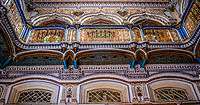Omar Hayat Mahal

Omar Hayat Mahal Library (also spelled as Umer Hayat Mahal Library or known as Gulzar Manzil) (Urdu: عمر حیات محل) is an early 20th-century wooden architectural wonder of Chiniot, Pakistan.
Omar Hayat Palace is a five story building which stands in the heart of the city. Two upper stories were removed in 1993 due to heavy rainfall and storms which may have affected the adjoining buildings. It is a great tourist attraction for both local and foreign visitors.
History
Members of the Shaikh family migrated from Calcutta to Chiniot around the 18th or 19th century. Sheikh Omar Hayat who was a successful trader born in a rich family. He decided to construct a magnificent palace for his newborn son in 1923.
Syed Hassan Shah was assigned the task of palace's construction. He gathered many famous artisans from different places who continued working day and night for 10 ten years. Rahim Bakhsh Pirjha and Elahi Bakhsh Pirjha who were masters in manabat kari did wood carving.
Gazeteer Vol XXXII, Jhang district 1929 states, "The house built by Sheikh Omar Hayat is a sort of local wonder, as it's cost was Rs 400,000 to make and rises high above all other buildings of the area".The construction of the palace completed in 1935 and Seth Omar Hayat expired in same year just a couple of months before its completion.
History claims that Mr Hayat's only son Gulzar Muhammad's marriage in 1938 brought an ironic twist of fate in the shape of death . He (Gulzar) was found dead in the palace the very next day of his marriage. The news of son’s death lofted loads of grief on mother who died remembering him. Both the mother and the son were buried in the courtyard of the ground floor of the palace.
Mr Hayat's relatives left the palace thinking it as a subject to bad luck for sheikh family, while servants continued living for a couple of years and then parted from it. An orphanage was established by some religious leaders and then it was evacuated when its top story collapsed. Next came the Qabza groups who got shops and houses constructed on the piece of land lying next to it.
Architecture of the palace
The palace's building is perhaps the last of Mughal’s architectural style, or a Mughal Revival building ("revival" buildings are interpretations of an old architectural style by people of a later era). Unique carving cuts on the doors, windows and jhirokas reflect a colour of their own. The roofs, balconies, stairways, terrace and the stucco designs make a perfect interior. The facade of the building is decorated with a fine inlay of bricks, the dazzling shine of marble and picturesque shades help it rank among the great palaces of Mughal era landlords.
Recent status
Later on this placed was occupied by Qabza mafia who destroyed most of the building However seeing death of its glory in 1989, M. Athar Tahir, the then deputy commissioner of Jhang, took the palace into his custody. He removed the encroachments and started its renovation with an expenditure of Rs1,700,000.
It was handed over to local municipal committee and a library, cultural centre and a museum were new additions which regained some vigour. A rare collection of thousands of books and subscription for seven dailies was introduced to learners and It was publicly opened the then Punjab Governor, Mian Muhammad. On 7 June 1990,it was decided that the Gulzar Manzil be acquired for the people,be conserved and conservatively restored,not completely renovated.It was also decided that it should be accorded a more dynamic role in the life of Chiniot(Pakistan)thus the massive fund-raising drive was initiated for its conversion into a library and cultural centre. with the help from philanthropists,interested agencies and the Municipal Committee,Chiniot the conversion efforts commenced on 14 August 1990. Keeping the vision and wishes of its owner in view,the library in the Gulzar Manzil was named after Seth (Shaikh) Omar Hayat.. In Year 1997 the municipal committee refused to bear the expenses and terminated the subscription of newspapers and other reading materials. At present the palace is very much out of sorts. Its walls have developed cracks rainy water pours in. The woodwork has lost colour.
| Wikimedia Commons has media related to Omar Hayat Mahal, Chiniot. |